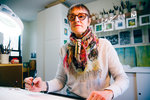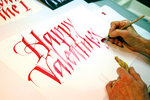A well-handwritten word can convey warm emotions and romance in ways print simply cannot.
“There is nothing like getting something handmade,” said Rebecca Wild, a professional calli-rapher who lives in Port Townsend. “There is nothing like taking your words and putting them into something beautiful. There is nothing like opening an envelope that has a real handwritten card and a message that is not just manufactured but built by hand.”
While the art of handwriting may be thing of the past, that shouldn’t prevent people from crafting a handwritten valentine, Wild said.
“Sit down and use your own handwriting,” she said. “No matter how insecure you feel about your handwriting, use it.”
Wild finds writing out beautiful letters and words can bring a sense of well-being.
This item is available in full to subscribers.
We have recently launched a new and improved website. To continue reading, you will need to either log into your subscriber account, or purchase a new subscription.
If you had an active account on our previous website, then you have an account here. Simply reset your password to regain access to your account.
If you did not have an account on our previous website, but are a current print subscriber, click here to set up your website account.
Otherwise, click here to view your options for subscribing.
* Having trouble? Call our circulation department at 360-385-2900, or email our support.
Please log in to continue |
|


A well-handwritten word can convey warm emotions and romance in ways print simply cannot.
“There is nothing like getting something handmade,” said Rebecca Wild, a professional calli-rapher who lives in Port Townsend. “There is nothing like taking your words and putting them into something beautiful. There is nothing like opening an envelope that has a real handwritten card and a message that is not just manufactured but built by hand.”
While the art of handwriting may be thing of the past, that shouldn’t prevent people from crafting a handwritten valentine, Wild said.
“Sit down and use your own handwriting,” she said. “No matter how insecure you feel about your handwriting, use it.”
Wild finds writing out beautiful letters and words can bring a sense of well-being.
“I just love putting ink (on paper) — running this line from my mind to my arm to my hand to paper and watching those form. Calligraphy is pretty magical to watch,” she said. “I find that when I am watching calligraphers do it, it is a pretty magical craft.”
Wild’s husband, Brad Miller, finds her work deeply personal.
“It is exquisite, it’s passionate, it’s expressive,” he said. “It is an expression of her and is wonderful to look at. Perhaps that is romantic. It is physical expression of who she is and how she thinks and how she looks at life.”
Miller said he’s grateful to live with a calligrapher, and he receives many moving pieces from Wild.
“It is kind of embarrassing because (my gifts) are pretty rude and crude, usually involving chocolate instead of words,” he said.
Ancient artform
“The word calligraphy comes from the Greek words kallos, meaning beauty, and graphein, to write,” Wild said. “Calligraphy is a dear old craft with a utilitarian history. But there is a vibrant and experimental calligraphy world out there where contemporary calligraphers are pushing the boundaries. It is very exciting. It’s creative usage has become much broader.”
In the modern age of printed documents and emails, calligraphy has become less studied than in decades past. But it is enjoying a resurgence, Wild said.
“It is a vanishing artform, although there are a lot of young people that have gotten really interested, and I think it is part of the whole do-it-yourself movement,” she said. “There is emphasis on beauty and relation of letter to line.”
To keep the art form alive, Wild is passing along her skills to a new generation as a calligraphy teacher at Port Townsend School of the Arts, where she will teach a five-week beginning calligraphy class this spring. She said she encourages her students to “use every opportunity you can to practice your handwriting, to practice your forms.”
Borrowing the style of letters is not plagiarism but a high form of flattery, she said.
“If you see somebody’s ‘m’ that you love, take it,” she said. “I have stolen from my good friend and my sister to use in my handwriting.”
Inspired by grandma
Wild’s lifelong love of the handwritten word began as she watched her grandma pen letters.
“I grew up in West Virginia, and my grandmother, who was born in 1884, learned the Spencerian Script, which was the hand of commerce back then,” Wild said. “She had this really exquisite handwriting, and I grew up with the awareness of handwriting, and I always liked to print and play with pens.”
Wild attended Montana State University, where she majored in graphic design.
“My boss came to me one day, and he asked me if I knew how to do calligraphy,” she said. “He needed me to make some certificates. I lied and I told him I did. He needed two little certificates with illustrations of like six lines each. I went across the hall to the bookstore and I bought a Speedball lettering guide and a pen, and I proceeded to trace every single letter, and it took me 16 hours to do two tiny certificates. But then I was launched.”
Impressed with her work, Wild’s boss requested additional orders.
“I kept getting more, but I always traced the forms,” Wild said. “I didn’t learn them on my own. I traced them from the book. I would blow them up and trace them. Then one day about a year later, I was in the student union building, and I saw a calligraphy show by two calligraphers in Montana, and I was bowled over. I had no idea there was this whole world of calligraphy as art. I took one look and said, ‘That is what I want to do.’”
Wild’s mother encouraged her to contact a cousin, a professional calligrapher in Washington, D.C. Wild did so, and in 1981 she landed a job as a calligrapher in the nation’s capital.
“That was how I started,” Wild said. “I thought, ‘I’ll learn this in a couple of months.’ It was two and half years of eight hours a day, five days a week in a studio, a black, windowless room, and I did calligraphy all day long for the government and government projects, mostly.”
After her tenure was complete, Wild moved to the West Coast in 1983 and learned a new style of calligraphy.
“All the work out here was really loose, and I had to relearn to play jazz, I like to say,” she said.
Keeping a steady hand
Much like a surgeon, Wild has to keep a steady hand when she performs her work.
“I wait until the coffee has worn off,” she said with a chuckle. “If I am working big, it doesn’t matter, but if I am working tiny, I can’t drink coffee. Big lettering I can do now matter what. I could have espresso and still be able to do it. Not the little stuff.”
To get in the zone, Wild likes to work in seclusion in her tidy and well-lit upstairs studio.
“Solitude helps,” she said. “The less distraction, the better. An organized studio clears my head. The process of making letters is very meditative. It requires a lot of focus. If my body is tense, it is reflected in my work, especially when it comes to making small letterforms. So I need to take a lot of breaks to stretch and open my shoulders. Walks help.
“Once I start the pen dance with ink to paper, it brings me such pleasure, and it is something that I do that brings delight to others,” she said.
These days, Wild works as a freelancer and has created works for many local residents and even the Jefferson County Sheriff’s Office.
For more information about Wild, visit https://www.rwildart.com.